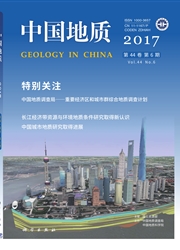

 中文摘要:
中文摘要:
乌努格吐山斑岩型铜钼矿是德尔布干成矿带中的典型矿床之一。该文在分析岩石地球化学特征的基础上,采用等浓度线法和坪台法对成矿元素的迁移特征进行定量计算和分析,借此探讨了成矿过程。结果显示:由于温度不断降低,SiO2、Al2O3、MgO、Fe2O3发生迁移并形成了不同的矿物,质量迁移比例由内向外逐渐增大,并且形成的矿物与乌努格吐山蚀变分带特征矿物石英、钾长石、绢云母、水白云母的出现相一致,主量元素的迁移导致乌努格吐山形成明显的蚀变分带。成矿元素Cu、Mo在各蚀变分带中均显示极度带入的特征,矿化强则带出比率高。在斜长石的蚀变过程中,由于CO32-的络合作用Mo被析出转移到热液流体中去,然后发生迁移。Zn、Pb等则从内带向外带由带出变成带入,最终在最外带中富集。
 英文摘要:
英文摘要:
The Wunugetushan porphyry Cu-Mo deposit is one of the typical deposits in the Deerbugan metallogenic belt. Combining laboratory analysis with field observations, the authors quantified the migration of ore-forming elements by immobile plateau method and the formula given by Grant, and discussed the metallogenic processes. The results show that the percentages of SiO2, Al2O3, MgO, Fe2O3 gradual increased from the inner part to the outer part due to the continuous decrease of temperature, the migration of major elements led to the formation of some minerals whose zoning is consistent with the zoning of characteristic minerals such as quartz, feldspar, sericite and muscovite in Wunugetushan alteration zone. The magma originated from the mantle and was contaminated by crustal materials during the collision between Siberia plate and Mongolia plate. Cu, Mo were brought into the alteration zone, the percentage of the gaining (Xgp) of Cu and Mo was gradually reduced from the inner part to the outer part. Mo came from the surrounding rocks, whereas Cu was from parent rocks. In the course of alteration of plagioclase Mo precipitated and entered hydrothermal solution due to the complexation of CO32-, and then migrated. Pb and Zn were taken out of the inner zone and brought into the outer zone, and the elements were eventually concentrated in the outermost zone.
 同期刊论文项目
同期刊论文项目
 同项目期刊论文
同项目期刊论文
 期刊信息
期刊信息
